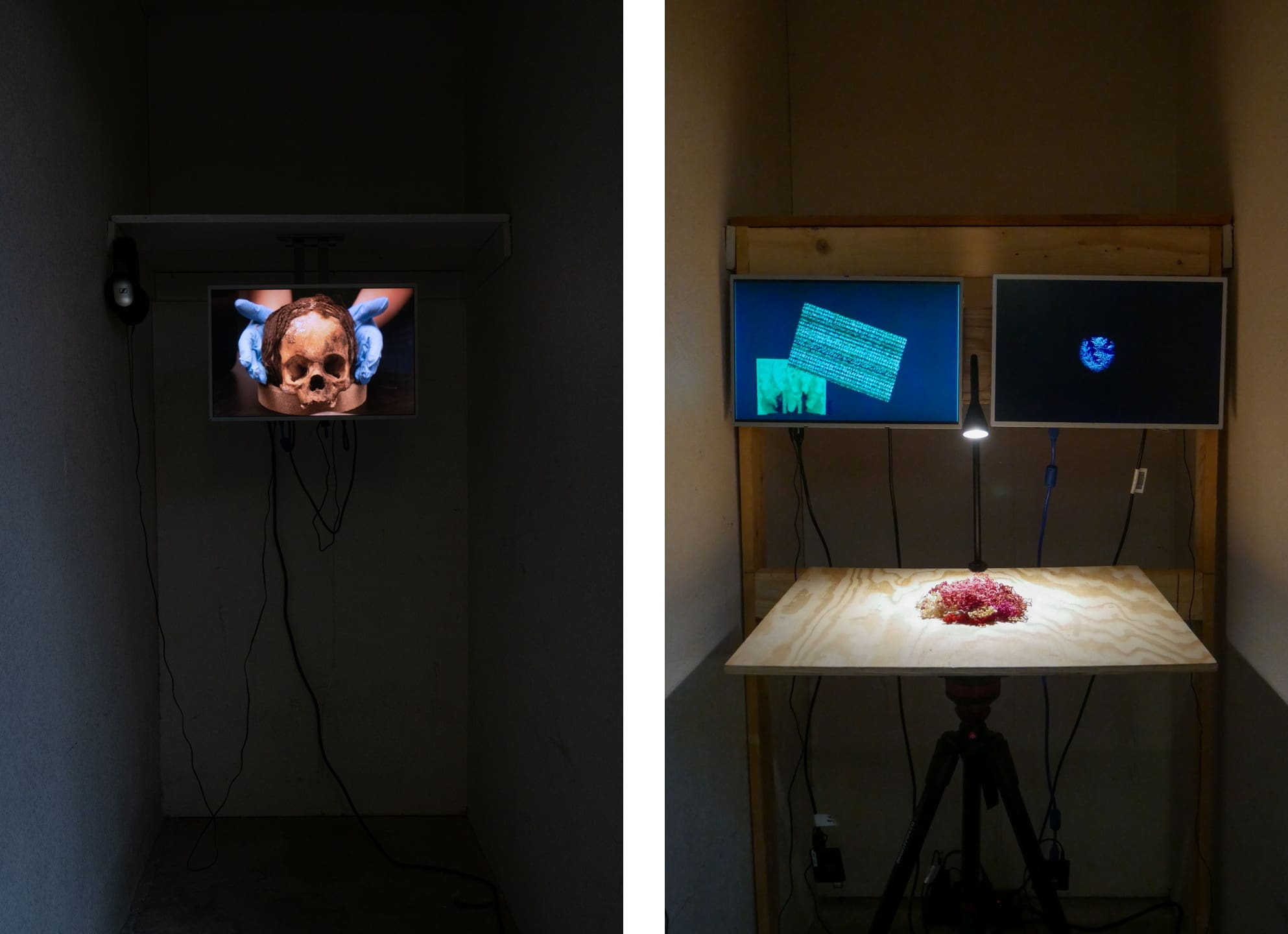
S3026 is an artist-run space created by Laurids Andersen Sonne—a 2018 graduate of Duke’s MFA in Experimental and Documentary Arts program—and his colleague Nima Bahrehmand. What used to be merely the storage unit for Sonne’s apartment in Boulder, Colorado, is now a single-person-occupancy gallery open to visitors 24/7 via the use of a combination padlock.
In the email interview that follows, the artists discuss their project and the motivations behind it.
Why did you decide to launch this effort?
We had been toying with the idea of collaborating on some form of loose curatorial platform, and had been joking about using the exterior storage unit right next to Laurids’ apartment for it. When the lockdown happened, our other plans were stalled. Yet, the need to show and share works of art became more urgent.
Creating the gallery was also a gut reaction to the ease and laxness with which we as individuals and institutions moved into the virtual online world. We are concerned about the wholesale, institution-driven acceptance of the virtual as the de facto space we now have to inhabit as social creatures. And we are concerned about the accompanying conflation of living space and workspace.
For us, S3026 strikes a middle ground between taking our current biological circumstances seriously and raising concerns about the collective ways we are normalizing new modes of interaction. By providing a single-person-occupancy exhibition space equipped with hand sanitizer and showing work that resonates with the past, present and future, we believe that we are making a small gesture towards other ways of adapting to the circumstances—ways that are not dictated top down by institutional interests.
What do you hope to achieve?
It is our hope to provide a physical space for a direct, in-person experience of art, whether it is screen-based or installation work. We are not trying to achieve anything grand. S3026 is just a place to go that’s neither home nor the grocery store, a place to get some relief from Zoom calls, email and other online activities. It is a sort of cryogenic chamber for the mind.
We also believe that this “chamber” gives people a way to interact with works of art on an intimate level, where one is forced to challenge oneself on an affective plane, in relation to the work, without any environmental distractions.
Since there are no social gatherings and the space is limited to one person, there is no one for visitors to converse with about the work they see. The experience can become a conversation, or a confession, between the work of art and the individual. We believe that such forms of confession are needed in this current moment, when perceptions of truth and reality have become increasingly unstable.

What has been the response—both by contributing artists, and by visitors?
The artists showing work have been extremely open with their time and desire to share their work, and for that we are extremely thankful. We don’t hear that much back from visitors, and that’s fine—we don’t expect anything from them except that they have a private conversation with the art. The response from the few visitors we have connected with has been great, though.
Curatorially, it has been exciting for us to facilitate the space. It has given us the opportunity to interact with the artists about shared interests, whether we’re discussing the sequencing of images, or developing something new and specific for the space, or opening up new conversations about older work.
How can people see the work/engage with the project?
As S3026 is all about bringing people into the same room as the artwork, the way to engage with it is to go to the physical space. We are intentionally keeping the online presence minimal, but we do keep a retroactive list of the works and artists featured.
Currently, our focus is local. The project is a way for us to bring in work by people that we know or whose work we admire, from near and far, and share it with the arts community in Boulder and Denver.
How is COVID-19 impacting your personal artistic practice?
Nima: Moving from Austin to Boulder in August, I feel like I was still transitioning when COVID-19 sent us into lock down and extended the transition phase. So, in a way S3026 has been a way for me to build community here while continuing to be in contact with my community elsewhere.
Laurids: I have had to accept that this moment is a period of deeper reflection and introspection. With that, I have intensified vehicles that were already part of my everyday being, like wandering on a bicycle, and birdwatching.
Laurids and Nima are colleagues in the PhD program in Emergent Technologies and Media Art Practices (ETMAP) at University of Colorado Boulder.
Laurids Andersen Sonne is a Danish interdisciplinary artist. His work spans 16mm film, video, installation, sculpture, performance, and socially engaged art projects. Laurids sees art as a catalyst for reflection on being, a way to explore, entwine and unfold serious topics. Laurids holds a BA in Social Anthropology from Lund University and an MFA in Experimental and Documentary Arts from Duke University.
Nima Bahrehmand (b. Kerman, Iran) is an Artist/artist who deals with video installation, performative action, and technology outcomes. He finds significance in small gestures. By merging several seemingly incompatible worlds into a new universe, he makes work that deals with the documentation of events and the politics of re-representation of these fragments. Nima received his BFA in painting from the University of Kerman, Iran, MA from School of Art, Ghent, Belgium, and MFA in studio art, transmedia from the University of Texas at Austin.


